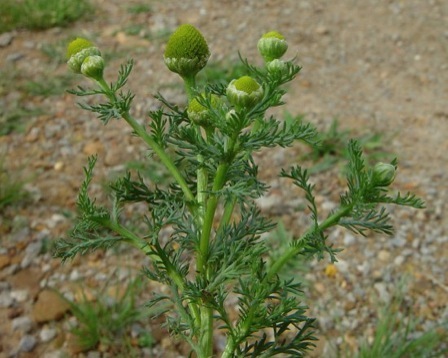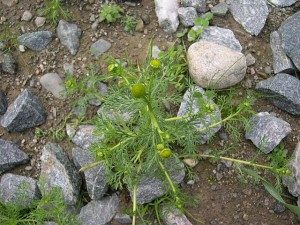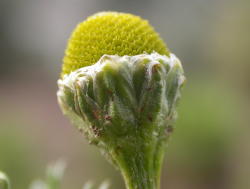Matricaria matricarioides for Your Tea & Salad
A hard-packed gravel driveway is the last place you would expect to find a delicate plant that makes an excellent tea and salad nibble yet that is where Matricaria discoidea* prefer to grow.
Every summer our driveway would be two glacial dirt ruts with a few plants struggling to survive in between. There I would find Pineapple Weed, the dominant plant of that micro environment along with struggling European plantains. Our horses, which were also our lawn mowers, always left the Pineapple Weed alone, all the more for me.
Kids do the most dangerous things and Pineapple Weed was one of the plants that I learned was edible from other kids. Actually, I learned quite a few that way. But, it was a different time, and era. We lived near to the wilderness in Maine with a lot of adults around who had foraged so the pass-along knowledge was good, though the identifications could be iffy. Many years later I tried transplanting Pineapple Weed to Florida but it was just too warm. Not only that but my Native Plant Society friends would have disowned me had I succeeded.
If you are inclined to gather this edible, Pineapple Weed can be confused with young Mayweed Chamomile (Anthemis cotula) or possibly Dog Fennel (Eupatorium capillifolium.) Neither of these, however, smell like pineapple when crushed, so you always want to check for that. Mayweed and Dogfennel also grow much taller than Pineapple Weed which in some environments won’t even get two inches high. Additionally, Dog Fennel has a strong balsam odor. Its common name fennel reflects what its leaves look like, not how it smells. Dog fennel has external and limited medicinal uses thus should not be consumed. Pineapple Weed, however, is related to the common night-time drink, chamomile tea which is Matricaria recutita.
Matricaria matricarioides (mat-rik-KAY-ree-uh mat-ri-kar-ee-OY-deez…. mat-ri-kar-ee-EE-des in Greek) is fairly easy to sort out. Matricaria’s base word is Matrix, Dead Latin for womb but that translates into “mother” and is used to mean it has medicinal uses. In contemporary terms we might say it is the Mother Of All Herbs. “-Oides” is Dead Latin’s version a Greek suffix which now means “look’s like.” It also tells you the naming botanist was having a bad day and couldn’t think of any thing really good to name the plant. So, matricarioides means “like the Matricaria.” So its name kind of means “mother herb like itself.” I think they could have done much better. Discoidea means disk. (disco-EE-dee-ah or THEE-sco-EE-dee-ah.)
Some people are allergic to this plant, so try carefully. It can also be used as an insect repellent.
(Some say M. matricarioides.)*
Green Deane’s “Itemized” Plant Profile
IDENTIFICATION: One or multiple flowers at the ends of the stems on short stalks, flowers cone-shaped, from 1/4 to 1/2 inch in diameter, greenish yellow in color, finely dissected leaves with a sweet “pineapple-like” aroma when crushed. .
TIME OF YEAR: A late summer or winter annual
ENVIRONMENT: Dry areas, rocky soil, waste ground, nurseries. Pineapple-weed is found throughout Canada the United States except for Georgia, Mississippi, Florida and Texas. As a cool weather plant it can be found in the northern areas of some southern states.
METHOD OF PREPARATION: Young flower buds in salads, or fresh or dried to make a tea. The entire plant can be used to repel insects.




